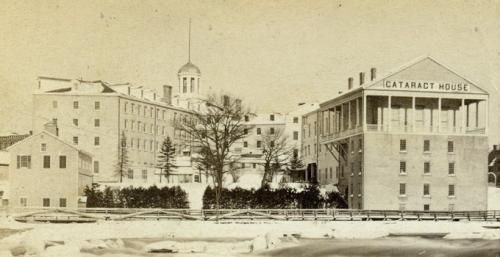Cataract House
African American waiters at the Cataract House organized one of the most important Underground Railroad networks in Niagara Falls.
Located on what is now Heritage Park at Buffalo Avenue and Old Main Street, and on the banks of the Niagara River, the Cataract House operated from 1825 to 1945. Over time, it was owned by well-known proprietors like Parkhurst Whitney, James Trott, and Peter Porter. The Cataract House was one of the oldest, largest, and most premier hotels in Niagara Falls.
By 1845, the Cataract House was a five-story hotel complete with balconies that overlooked the rapids. Guests enjoyed luxurious hotel rooms, large dining halls, a ballroom, and other amenities. Visitors from the United States and all over the world stayed at the Cataract House, including businessmen, tourists, political leaders, royalty, and nobility.
Amidst all the grandeur, important developments were taking place in the Cataract House. Whitney began hiring black waiters as early as the 1840s; many were born into and had likely escaped slavery in the South. They were a well-trained and highly professionalized waitstaff. The Cataract House is considered the first hotel in Niagara Falls to hire black waiters in the city’s growing hospitality industry. It also employed black cooks, porters, bellhops, and janitors.
As a border city, Niagara Falls drew countless freedom seekers from the South who sought emancipation in Canada. It also attracted wealthy, white, southern families who stayed at the hotel and brought enslaved people to serve as valets or ladies’ maids. Underground Railroad conductors regularly stopped at the hotel to conduct business. These factors, combined with the large black workforce at the Cataract House, emboldened its workers to form a vast network of Underground Railroad activism.
Abolitionist waiters in particular assisted enslaved people in securing safe passage across the Niagara River into Canada. They shared important details about how to make the journey, putting their jobs and lives on the line. Headwaiter John Morrison ferried numerous freedom seekers across the river. He also tried to rescue a young woman from slavery alongside 20-30 other waiters who blocked and rushed a departing train. In 1853, around 60-100 waiters helped fellow waiter Patrick Sneed who, many believed, was falsely accused of murder in an attempt to force him back into slavery. The waiters dragged Sneed from police custody, barred the hotel doors, and conveyed him to a ferryboat.
Fire destroyed the hotel in 1945. Far from an opulent hotel near one of the world’s greatest natural wonders, the Cataract House stood as a beacon of hope for freedom seekers and is known today as “the center of Underground Railroad activism in Niagara Falls” and “one of the most important Underground Railroad nodes in the entire nation.
Hope L. Russell, Ph.D.


